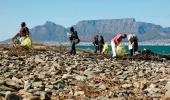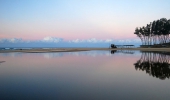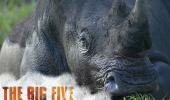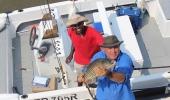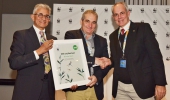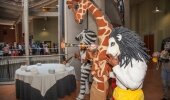Words: iSimangaliso Wetland Park Authority
The iSimangaliso Wetland Park Authority is committed to providing environmental education and awareness to communities, and has for the past eight years implemented an awareness programme, reaching out to school learners surrounding the Park.
iSimangaliso has recently purchased a bus solely for awareness activities, vibrantly branded in the Park’s signature colours. This transport addresses a key challenge as most of the schools surrounding the park fall within the lowest economic brackets, so that even though iSimangaliso provides discounted or free access, schools may still be unable to afford the transport to the Park.
“The iSimangaliso Environmental Education Programme gives the iSimangaliso Authority an opportunity to work with South Africa’s future leaders - the youth”, says Nerosha Govender, Manager of Development and Planning. “The primary goal of the programme is to create access for local youth by bringing learners from neighbouring schools into iSimangaliso Wetland Park, a World Heritage Site, and creating fun educational experiences around the natural and cultural heritage they see in the Park. The iSimangaliso Authority aims to bring 150 schools, totalling 2400 learners and 300 educators, into the Park over the next two years. This is approximately quarter of the number of schools within the Obanjeni District surrounding iSimangaliso.” The current programme is funded by the Department of Environmental Affairs and the National Lottery Distribution Trust Fund.
Programme implementation
The Authority team, led by Nerosha, has prepared educational material for the awareness activities and trained four environmental education facilitators from local communities to facilitate all EE field trips under this programme: Mary Barnes, Vusi Mthiyane, Ntombifuthi Mathenjwa and Jabulani Mbonambi.
African Conservation Trust (ACT) was hired to provide logistical support in implementation of the programme. The ACT team, together with Sifiso Vumase (Environmental Education intern, iSimangaliso Wetland Park Authority) and Nerosha, work together in implementing the programme, including the selection of schools from an established database.
In the 2015 programme, 45 schools were hosted in two of the Park’s ‘jewels’ namely the Eastern Shores and Sodwana Bay. These schools are from the communities surrounding Mtubatuba, uMkhuze and Mbazwana. Learners are transported to and from the Park using the new purpose-designed iSimangaliso bus and learners are provided with caps, information materials and a packed lunch. Educators at each school select the representatives based on their interest in conservation and/or tourism.
Sifiso Vumase (above left), a former bursary student supported through iSimangaliso’s Access to Higher Education Programme, now working as an Environmental Education intern at iSimangaliso, says he has benefited a lot from participating in the EE programme. Having graduated with a B-Tech in Tourism Management from DUT, he began his internship at the iSimangaliso Authority in 2014. Sifiso was charged with the responsibility of coordinating and facilitating the EE programme and he feels that has given him a wonderful opportunity to interact with different stakeholders such as the Department of Education, African Conservation Trust and 90% of the schools under uMkhanyakude District.
A day in the programme
Vumase describes a typical EE outing as follows: “The EE facilitators and I meet and greet learners at the Park’s gate where learners are given an introduction to iSimangaliso and the role of the iSimangaliso Authority. On the Eastern Shores, learners explore the Park using different game viewing roads that provide access to varied habitats such as grasslands, wetlands and coastal dune forest as well as the wildlife that lives there. We visit the kuMziki Lookout point on the road towards Mission Rocks and learners have the opportunity to ask questions relating to the natural and cultural features of the Park’s plants, animals and sites. In response, the EE facilitators tell stories such as how ancient people used isundu (wild date palm) to make palm wine and why the strange behaviour of Blue wildebeest was traditionally associated with the behaviour of iSangoma (the traditional healer).”
“At kuMziki Lookout point, learners get to touch and feel plants and trees, and enjoy a panoramic view of the five major interlinking ecosystems of iSimangaliso. They learn the importance of these ecosystems and the history of the landscape and its people. Our passionate EE facilitators have coined the slogan “JUICE”, an acronym which stands for “Join us in Conserving Environment” which aptly represents the learners’ pledge in conserving biodiversity.”
At Sodwana Bay and Mission Rocks, learners focus on exploring different marine animals and plants found on the rocky shores. They are able to see, touch and feel rock crabs, lobsters, mussels, limpets, sea cucumbers, sea urchins, seaweed and coral. For most of them, this is their first time seeing what lies beneath the sea. Educational activities like the marine food web and turtle awareness games are important tools in teaching learners in a fun and interactive setting, about the interconnectivity of all plants and animals within an ecosystem.
What teachers and learners had to say:
Ophaphasi Primary School:
Teacher - Mr Bafana Ndebele: “The trip was very good. We learned about different things that we did not know about nature, such as the difference between the high tide and low tide and two forces that influence the tide movement. We wish iSimangaliso would organise another trip that can take the whole school into the park to learn about different nature aspects.”
Learner - Nkululenko Shoba (Grade 6): “We have learned a lot about marine life. It was amazing to see and learn about animal species found in the rocky shores such as zebra fish and crabs. We also learned more about how dangerous ‘Big five’ animals are to human beings.”
Kwangxaba High School:
Teacher - Miss S.T Makhunga: “The fieldtrip was fruitful in many ways. We have learned about many things we did not know about both nature and the role of iSimangaliso Authority as managing authority. It was also great learning about different creatures found in the marine ecosystem.”
Learner - Siyabonga Ntuli (Grade 11): “We learned about the interaction of living and non-living organisms in the environment. It is good that the field trip has given us the opportunity to see physically some of the nature- related things that we learn in class. We have also learned that iSimangaliso Wetland Park is one of the World Heritages Sites and has ‘Big five’ animals, which some of us did not know.”
For more information on the iSimangaliso Wetland Park, follow us on Twitter, Instagram, Facebook and Youtube, or visit our website at www.isimangaliso.com. Media enquiries should be directed to Media Officer Siyabonga Mhlongo at or on 084 382 0884.

